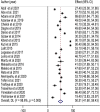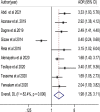Food hygiene practices and determinants among food handlers in Ethiopia: a systematic review and meta-analysis
- PMID: 35585619
- PMCID: PMC9118835
- DOI: 10.1186/s41182-022-00423-6
Food hygiene practices and determinants among food handlers in Ethiopia: a systematic review and meta-analysis
Abstract
Background: Food-borne diseases are a major public health concern worldwide, particularly in low and middle-income countries (LMICs), such as Ethiopia. Poor food hygiene practices primarily exacerbate food-borne illness transmission. Prior studies on the food hygiene practices among food handlers in Ethiopia were inconsistent. Therefore, this meta-analysis and systematic review aimed to estimate the pooled proportion of good food hygiene practices and identify the determinants in Ethiopia.
Methods: The preferred reporting items for systematic review and meta-analysis (PRISMA) instruments were used, and a systematic search was performed in the PubMed/MEDLINE, POPLINE, HINARI, Science Direct, Cochrane Library databases, and Google Scholar were systematically last searched on the 24th February 2022 for relevant articles. Only the observational studies that reported the proportion of good food hygiene practices and their associated factors among food handlers were included. The quality of the included studies was assessed by two independent authors. Articles with unclear methodologies and did not report the overall proportions of good food hygiene practice were excluded. The effect estimates for pooled proportion and pooled odds ratio (POR) along with a 95% confidence interval (CI) were determined conducting using DerSimonian-Laird's random effect model.
Results: Among 817 retrieved studies, 23 eligible articles with a total sample size of 7153 study participants were included in the meta-analysis. The pooled proportion of good food hygiene practices among food handlers was 50.5% [95% CI: (41.6, 59.4%]; I2 = 98.7%, p value = 0.001]. Food handlers with formal education (POR = 4.60, 95% CI: 3.05, 6.93), good knowledge (POR = 1.98, 95% CI: 1.26, 3.11), training (POR = 3.52, 95% CI: 2.35, 5.28), and a positive attitude (POR = 3.41, 95% CI: 2.52, 4.61) about food hygiene components, as well as regular medical checkups (POR = 6.75, 95% CI: 4.49) were significantly associated with good food hygiene practice.
Conclusions: Only half of Ethiopia's food handlers had good food hygiene practice.
Implication of the study: The key elements of effective food hygiene practice that will aid in the development of feasible interventions to increase food handler compliance with food hygiene components have been identified.
Keywords: Ethiopia; Food handler; Food hygiene; Food safety; Good practice.
© 2022. The Author(s).
Conflict of interest statement
There are no competing interests declared by the authors.
Figures









Similar articles
-
A systematic review and meta-analysis of food handling practices in Ghana vis-a-vis the associated factors among food handlers during 2009 and 2022.Sci Rep. 2023 Oct 31;13(1):18748. doi: 10.1038/s41598-023-46150-8. Sci Rep. 2023. PMID: 37907615 Free PMC article.
-
Hygienic Food Handling Practices and Associated Factors Among Food Handlers in Ethiopia: A Systematic Review and Meta-Analysis.Environ Health Insights. 2022 Jun 4;16:11786302221105320. doi: 10.1177/11786302221105320. eCollection 2022. Environ Health Insights. 2022. PMID: 35677751 Free PMC article. Review.
-
Intestinal parasites among food handlers of food service establishments in Ethiopia: a systematic review and meta-analysis.BMC Public Health. 2020 Jan 16;20(1):73. doi: 10.1186/s12889-020-8167-1. BMC Public Health. 2020. PMID: 31948421 Free PMC article.
-
Food handling practice and associated factors among food handlers in public food establishments of Ethiopia: a systematic review and meta-analysis.BMJ Open. 2022 Mar 15;12(3):e051310. doi: 10.1136/bmjopen-2021-051310. BMJ Open. 2022. PMID: 35292488 Free PMC article.
-
Prevalence and factors associated with intestinal parasitic infections among food handlers working at higher public University student's cafeterias and public food establishments in Ethiopia: a systematic review and meta-analysis.BMC Infect Dis. 2020 Feb 19;20(1):156. doi: 10.1186/s12879-020-4884-4. BMC Infect Dis. 2020. PMID: 32075585 Free PMC article.
Cited by
-
Value chain hygiene practices and microbial contamination of street and market vended ready-to-eat grasshopper, Ruspolia differens in Uganda: Implications for food safety and public health.Heliyon. 2024 Feb 8;10(4):e25614. doi: 10.1016/j.heliyon.2024.e25614. eCollection 2024 Feb 29. Heliyon. 2024. PMID: 38375279 Free PMC article.
-
Food Safety and hygiene practices and the Determinants among street vendors during the Chain of Food Production in Northwest Ethiopia.Heliyon. 2023 Nov 28;9(12):e22965. doi: 10.1016/j.heliyon.2023.e22965. eCollection 2023 Dec. Heliyon. 2023. PMID: 38076104 Free PMC article.
-
Food hygiene practice and associated factors among food handlers working in food establishments in sub-Saharan Africa: a systematic review and meta-analysis.Prim Health Care Res Dev. 2025 Feb 21;26:e13. doi: 10.1017/S146342362500009X. Prim Health Care Res Dev. 2025. PMID: 39980317 Free PMC article.
-
Bacterial foodborne illness and Escherichia coli O157:H7 strain infection among asymptomatic food handlers in Northeast Ethiopia: Implication for hygienic practices and mass-screening.Health Sci Rep. 2024 Jun 18;7(6):e2199. doi: 10.1002/hsr2.2199. eCollection 2024 Jun. Health Sci Rep. 2024. PMID: 38895551 Free PMC article.
-
Knowledge, Attitude, and Practices on Food Safety among Food Handlers Working in Public Food Service Establishments in Lemi Kura Subcity, Addis Ababa, Ethiopia.Biomed Res Int. 2024 Jan 23;2024:2675894. doi: 10.1155/2024/2675894. eCollection 2024. Biomed Res Int. 2024. PMID: 38292064 Free PMC article.
References
-
- Grace D. Food safety in developing countries: research gaps and opportunities.
-
- World Health Organization. National systems to support drinking-water: sanitation and hygiene: global status report 2019: UN-Water global analysis and assessment of sanitation and drinking-water: GLAAS 2019 report.
-
- Biran A, Curtis V, Gautam OP, Greenland K, Islam MS, Schmidt WP, Sijbesma C, Sumpter C, Torondel B. Background paper on measuring WASH and food hygiene practices–definition of goals to be tackled post-2015 by the Joint Monitoring Programme. London Sch Hyg Trop Med. 2012;2012:81.
-
- Havelaar AH, Kirk MD, Torgerson PR, Gibb HJ, Hald T, Lake RJ, Praet N, Bellinger DC, De Silva NR, Gargouri N, Speybroeck N. World Health Organization global estimates and regional comparisons of the burden of foodborne disease in 2010. PLoS Med. 2015;12(12):e1001923. doi: 10.1371/journal.pmed.1001923. - DOI - PMC - PubMed
LinkOut - more resources
Full Text Sources
Research Materials
